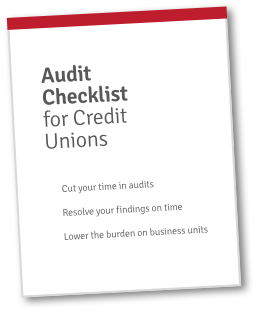Do you know of anyone who looks forward to credit union exams? Do they have NCUA rules and regulations tattooed on their arms? Do they read article after article exploring various credit union compliance resources?
We don’t. And yet, here we are.
Examinations aren’t designed to be pleasant, even when you are doing everything right. When you miss a detail or provide conflicting information, that’s when authorities raise concerns.
How To Reduce Risk in Credit Union Audits and Exams
There are several things you can do to reduce risk in your credit union audits and exams. These strategies will improve your audit results and performance over time. They’ll also protect you from an examiner’s findings (or DORs).
1. Use Credit Union Compliance Resources
There are several blogs and publications dedicated to audit and compliance. These are seven of our favorite credit union audit and compliance publications.
Staying on top of the latest credit union audit news—and getting insights from credit union auditors—helps immensely with preparation, best practices, and tool use.
2. Simplify!
Regulatory examinations are complex. Questions from regulators often generate internal anxiety and a flurry of activity. A full set of credit union exam questions can be a nightmare to organize.
So, introduce simplicity and transparency into your credit union’s response. Automation helps. So does centralizing document storage and communications. The fewer moving parts, the better.
3. Include the Right People
Make a list of your reliable, go-to experts. Ask yourself who else in the organization could provide insight? Who else needs to review the material before you hand it over? When and how should you involve our outside counsel?
Credit union exams go much more smoothly when you have a knowledgeable, experienced team at the ready.
4. Audit Trail, Audit Trail, Audit Trail
When anything happens, it needs to be auditable. Keep note:
- Who authored this response?
- Who saw it but didn’t provide feedback?
- Who reviewed it?
- Who didn’t?
All activity should be easily accessible. Keep a clear audit trail to improve internal confidence and give regulatory authorities confidence in your process.
5. Consult the Past
Over the years, your credit union has invested a lot of time in audit and examination responses.
Don’t reinvent the wheel every time.
Consult the people you’ve relied on in the past. Leverage the responses you’ve produced in the past.
For a better idea of what you can use from the past, download our Credit Union Audit Checklist.
6. Use Our Findings Accountability Framework
Our Findings Accountability Framework is a three-tiered approach to resolving findings. It’s not a product and there is no purchase necessary. Here’s what it involves:
We’ve helped credit unions reduce their overall audit times considerably—and reduce administrative time by 50%.
Additional Credit Union Compliance Resources
Regardless of your past experience, credit union regulatory activity can still throw curveballs.
Join us for our next masterclass of our proven Findings Accountability Framework for credit union auditors.
For other great blogs, check out the links below:
The Hidden Risks in Credit Union Regulatory Examinations - and How to Avoid Them
Using the NCUA Examiner's Guide as a Resource to Help Your Credit Union



 Get FREE Access to the Audit Checklist for Credit Unions!
Get FREE Access to the Audit Checklist for Credit Unions!


